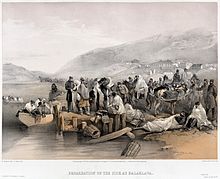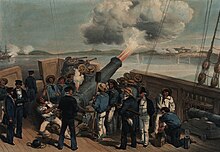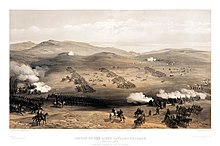William Simpson (artist)



William Simpson (born October 28, 1823 in Glasgow , † August 17, 1899 in London ) was a Scottish war correspondent and artist who specialized in the depiction of acts of war . He became famous for his depictions from the Crimean War, in which, among other things, he also depicted the suffering of the common soldiers. Together with William Howard Russell , Thomas Chenery and Florence Nightingale , he contributed to making the British public aware of the poor supply of their own troops.
Early years and the Crimean War
William Simpson was born in Glasgow on October 28, 1823, to a poor family. His father was an alcoholic and from 1834 he lived with his grandmother. He only started attending school at this point. A few years later he became an apprentice at a company in Glasgow specializing in the production of lithographs. During these years he attended Andersonian University and the Mechanics Institute in the evenings. In 1854 he was commissioned to illustrate the battle of the Alma with pictures . In anticipation of the conquest of Sevastopol , he was also commissioned to request lithographs for it. He himself increasingly insisted that he should be allowed to travel to the Crimea to make drawings on site.
William Simpson arrived in the Crimean Peninsula on November 15, 1854. What really impressed him was the suffering of the common soldiers. British troops, for example , had been victorious in the Battle of the Alma on September 20, 1854, but the consequences of mismanagement, incorrect preparation and logistical incompetence were clearly evident. In contrast to the French troops, there were no carriers or wagons to transport the wounded from the battlefield. Wounded and sick people who made it to the port waited days or weeks for the ships to take them to the military hospital in Scutari ( Üsküdar ). The crossing to Scutari took between two days and a week, depending on the type of ship and weather conditions. The survivors were then met with a poorly organized transport to the central military hospital ( Selimiye barracks ) on a hill above the port . The care of the sick and injured was probably no worse than during the Battle of Waterloo in June 1815, the last major battle in which the British Army was involved. For the first time, however, there were war correspondents who used telegraph to inform the British public about the events in Crimea without any major delay . Drastic reports by Times correspondents William Howard Russell and Thomas Chenery about the inadequate care of injured and sick soldiers caused astonishment and horror among the British public. Simpson's watercolors, reproduced by lithographers at Day & Son using the lithographic process, went a long way in creating a visual image of the suffering of British soldiers for the British public. He did not leave the Crimea until the fall of 1855.
Simpson received £ 20 for each of his watercolors. The company he worked for put together two large portfolios of over eighty lithographs, which were sold under the title The Seat of the War in the East in an edition of 2,000.
Later years
On May 10, 1857, there was an open revolt in Merath by Hindu and Muslim soldiers against their British commanders. The so-called Sepoy Rebellion quickly spread across northern India. British troops largely crushed the uprising during 1858. William Simpson was sent to India to create a portfolio similar to that of the Crimean War. He arrived in India on October 29, 1859 and toured large parts of India. In February 1862 he left India and upon his return to London had to find out that his client was unable to publish such a portfolio due to financial difficulties. The 240 watercolors that he had delivered to Day & Son were sold as bankruptcy property. Only fifty of his watercolors were published as chromolithographs .
In 1866 the Illustrated London News commissioned Simpson with some drawings of the visit of the Prince of Wales to Dunrobin Castle and then sent him to St. Petersburg, where the Prince of Wales attended the Tsarevich's Zeirat. Two years later he was hired to accompany the British Ethiopia expedition of 1868 . His watercolors became part of the portfolio that the Illustrated London News published in memory of this punitive expedition. In 1875 he accompanied the Prince of Wales to India. The warplaces that William Simpson traveled to in the years to come include the Franco-German War and the Second Anglo-Afghan War .
Publications
- India ancient and modern: a series of illustrations of the country and the people of India and adjacent territories; executed in chromo-lithography from drawings by William Simpson; with descriptive literature by John William Kaye . London: Day and Son, London 1867. Note: The folio edition of this book of 50 lithographs fetched £ 25,000 at Sotheby in 2008
- Meeting the Sun: a Journey all round the World through Egypt, China, Japan and California, including an account of the marriage ceremonies of the emperor of China . Publisher: Longmans, Green, Reader, and Dyer, London 1874.
- Picturesque people: being groups from all quarters of the globe . Publisher: London: WM Thompson, London 1876.
- Sculptured Tope on an old stone at Dras, Ladak. Publisher: Royal Asiatic Society 1882.
- The Buddhist Praying Wheel Publisher: Macmillan & Co., London, 1896.
- The Jonah Legend . Publisher: Grant Richards London 1899.
-
Glasgow in the Forties (ed. AH Miller). Morison Brothers, 1899
- George Brackenbury: Descriptive sketches. Illustrating Mr. William Simpson's drawings of the Seat of War in the East. Publisher: Paul and Dominic Colgnaghi & Son, London 1855
- George Brackenbury: The campaign in the Crimea: an historical sketch. Illustrated by forty plates from drawings taken on the spot by William Simpson. Publisher: Paul and Dominic Colgnaghi & Son, London 1855.
- William Simpson (posthumous) & George Brackenbury: The seat of war in the East, from eighty-one drawings made during the war in the Crimea. "Descriptive notices of the illustrations by George Brackenbury. The plates reproduced in half-tone from proofs of the first edition of 1855-56. Publisher: Day & Son, London 1902
- George Eyre-Todd: The autobiography of William Simpson, RI (Crimean Simpson) Publisher: T. Fisher Unwin, London 1903
Web links
- William Simpson (1823-1899) - "Prince of Pictorial Correspondents" by Adrian Lipscomb (Simpson's Great Grandson) - detailed biography
- Anne SK Brown Military Collection, Brown University Library Sketchbooks, watercolors, prints, diary during the Anglo-Ethiopian War 1878–79
- First Readings 2008- The Places in Between Parts of the diary kept in Afghanistan
- The Pall Mall Gallery Underground Jerusalem. Descriptive catalog of the above collection of water-color drawings by William Simpson, on view and for sale. From April 6th, 1872 Publisher: WM Thompson, London (Contains only image descriptions with prices.)
Single receipts
- ^ Helen Rappaport: No Place for Ladies - The Untold Story of Women in the Crimean War . Aurum Press Ltd, London 2007, ISBN 978-1-84513-314-6 , p. 75
- ^ Barbara Montgomer Dossey: Florence Nightingale - Mystic, Visionary, Healer , Springhouse Corporation, Springhouse 2000, ISBN 0-87434-984-2 , p. 107
- ^ Nancy Duin and Jenny Sutcliffe: History of Medicine , Verlag vgs, Cologne 1993, ISBN 3-8025-1267-7 , p. 79
- ^ Andrew Ward: Our bones are scattered. The cawnpore massacres and the indian mutiny of 1857. John Murray Publishers, London 2004, ISBN 0-7195-6410-7 , p. 402
| personal data | |
|---|---|
| SURNAME | Simpson, William |
| BRIEF DESCRIPTION | British war correspondent and artist |
| DATE OF BIRTH | October 28, 1823 |
| PLACE OF BIRTH | Glasgow |
| DATE OF DEATH | 17th August 1899 |
| Place of death | London |

